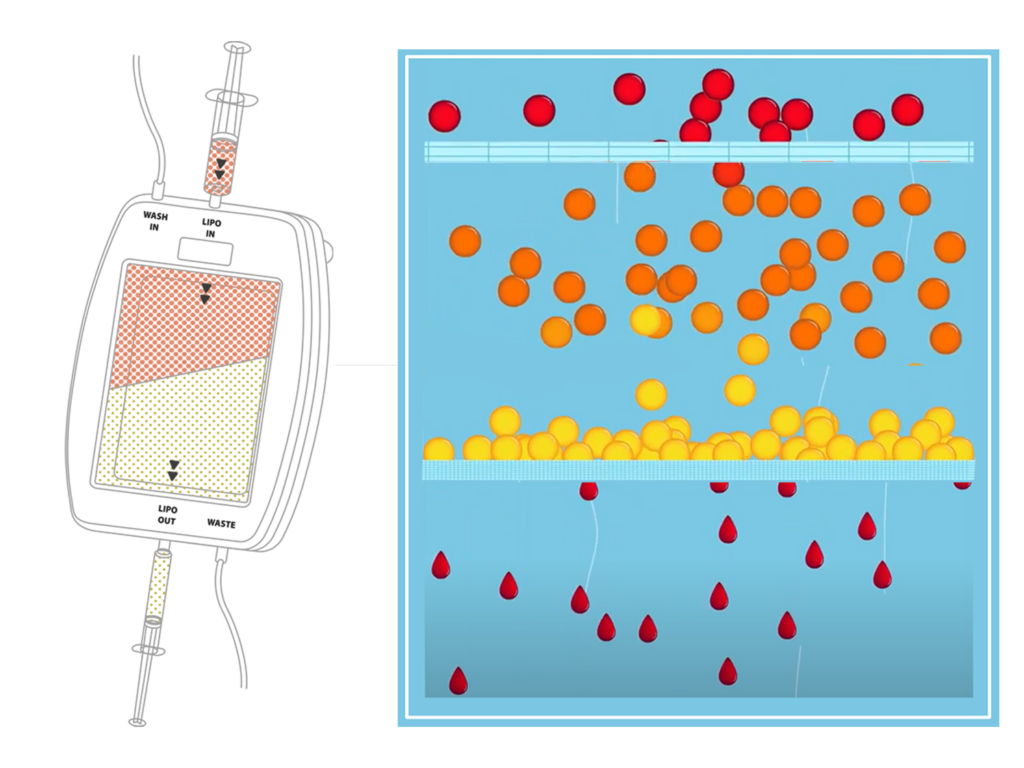In orthopaedics, addressing osteoarthritis and osteochondral defects remains a significant challenge. Recently, adipose tissue has gained attention as a promising therapeutic option due to its richness in adipose-derived stem cells (ADSCs) within the stromal vascular fraction (SVF). These ADSCs are known for their high proliferative capacity and regenerative potential, making them valuable for tissue repair applications.
The Multipotent Nature of ADSCs
ADSCs are multipotent and capable of differentiating into osteocytes, chondrocytes, myocytes, tenocytes, and other tissues (Alexander, 2012). They possess migratory abilities to navigate to the site of injury, modulate immune responses based on microenvironmental signals (Jimenez-Puerta, 2020), and exert paracrine effects through the release of growth factors and exosomes.
The Importance of Avoiding Centrifugation
Centrifugation of adipose tissue has been shown to reduce cell viability due to the higher gravitational forces and negative suction pressures involved, leading to cellular apoptosis. In contrast, washing ensures maximum cell viability after decantation, although decantation alone would not completely purify the tissue, especially from lidocaine residues. This makes washing optimal for preserving cellular integrity and functionality (Cucchiaini, 2016).
The Role of Continuous Washing
Continuous washing of adipose tissue ensures the removal of oleous components, blood residues, and Klein solution remnants. This process is crucial as it preserves ADSCs and the structural components of adipose tissue, including adipocytes, preadipocytes, and the entire SVF (Tremolada et al., 2016). The adipose tissue maintains its regenerative properties and potency by maintaining these components.
The Importance of Microfragmentation
Microfragmentation techniques involve creating micro lesions in the microvessels within adipose tissue, which activates the immediate release of growth factors and exosomes (Cohen & Holmes, 2016). This process promotes tissue regeneration and repair while facilitating the separation of fibrous tissue to ensure only high-quality, purified adipose tissue is used.
The LIPO-STEM DUO™ Advantage
The LIPO-STEM DUO™ device from BPB MEDICA™ avoids centrifugation and enables continuous washing and microfragmentation with minimal manipulation, resulting in a high-regenerative-potential microfat.
This innovative approach not only improves the quality of the processed tissue but also enhances its efficacy and extends the duration of its therapeutic effects. LIPO-STEM DUO™ operates through 6 easy steps within 6 minutes, resulting in superior purified and microfragmented adipose tissue ready for joint infiltration. This approach eliminates oleous and blood residues, which can cause inflammatory responses, compromising therapeutic outcomes. Additionally, proper removal of lidocaine from the Klein solution is crucial, as its presence could reduce cell viability significantly (Aronowitz & Ellenhorn, 2013)
Rationale for Use and Applications in Orthopaedics
ADSCs have a great ability in migration to be recruited rapidly into lesions, added to their differentiation, their capability of self-renewal, high plasticity, and immunosuppressive and anti-inflammatory action.
Therefore, they are used to:
• Reduce inflammation
• Decelerate the degeneration of the cartilage
• Provide viscosupplementation
• Manage pain
Processed adipose tissue can alleviate osteoarthritis symptoms and create a regenerative microenvironment, stimulating new tissue formation and enhancing healing processes (Gobbi et al., 2011). Furthermore, recent studies have shown the efficacy and long-term outcomes of intra-articular autologous micro-fragmented adipose tissue as a conservative treatment option for osteoarthritis (Natali et al., 2023).
Conclusion
Continuous washing and microfragmentation techniques, as exemplified by BPB MEDICA™’s LIPO-STEM DUO™, represent significant advancements in adipose tissue processing for orthopaedic applications. These innovations improve tissue quality, therapeutic efficacy, and the duration of therapeutic effects, offering promising solutions for patients with osteoarthritis and osteochondral defects.
References:
• Cohen, S. R., & Holmes, R. E. (2016). Micrografting of Fat: A Minimal Manipulation Approach to Harvesting and Processing Lipoaspirate. Aesthetic Surgery Journal, 36(6), 678-690.
• Aronowitz, J. A., & Ellenhorn, J. D. (2013). Adipose Stromal Vascular Fraction Content and Viability: Comparison of Four Cell Isolation Systems. Plastic and Reconstructive Surgery, 132(6), 932e-939e.
• Gobbi, A., Whyte, G. P., & Fillingham, Y. (2011). La cartilagine di adiposi iniettata per il trattamento della lesione di osteocondrale di ginnastica: risultati a 5 anni. The American Journal of Sports Medicine, 39(1), 95-105.
• Alexander, R. W. (2012). Understanding Adipose-derived Stromal Vascular Fraction (AD-SVF) Cell Biology and Use on the Basis of Cellular, Chemical, Structural and Paracrine Components: A Concise Review. Stem Cell Research & Therapy, 3(1), 11.
• Jimenez-Puerta, G. J. (2020). Role of Mesenchymal Stromal Cells as Therapeutic Agents: Potential Mechanisms of Action and Implications in Their Clinical Use. Journal of Clinical Medicine, 9(4), 1028.
• Cucchiaini, A. (2016). The effects of fat harvesting and preparation. Aesthetic Surgery Journal, 36(9), 975-982.
• Natali, S., Screpis, D., Patania, E., De Berardinis, L., Benoni, A., Piovan, G., Iacono, V., Magnan, B., Gigante, A. P., & Zorzi, C. (2023). Efficacy and Long-Term Outcomes of Intra-Articular Autologous Micro-Fragmented Adipose Tissue in Individuals with Glenohumeral Osteoarthritis: A 36-Month Follow-Up Study. Journal of Clinical Medicine, 12(5), 1168.



